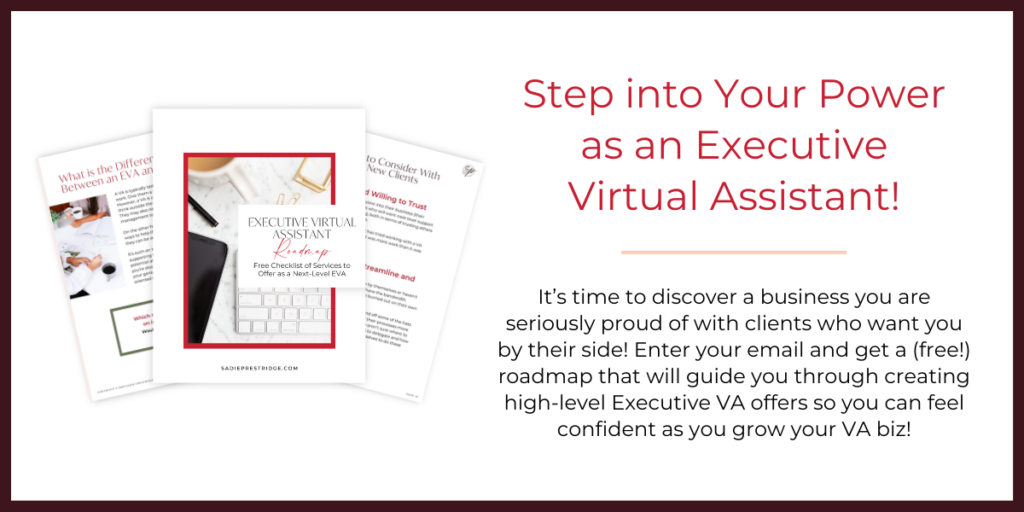One of the great things about being an executive virtual assistant is that you get to help your clients improve their businesses and do more of their genius work. But if they’re stuck in decision fatigue and have a hard time knowing what to delegate, it can be a rocky relationship, to say the least!
A lot of times, new EVAs will come to us and say they don’t know how to help their CEOs. CEOs won’t give up control, often because they think it’s easier to do things themselves rather than train an assistant to help them.
This really becomes a problem when you’re hired to help, but then can’t or aren’t allowed to help! I want you to have a thriving, sustainable business, so learning how to work with CEOs and help them move past decision fatigue so they can delegate to you will improve your relationships and client experience.
What is Decision Fatigue
Decision fatigue is a difficulty in decision-making because of the number of decisions you need to make. It usually hits when you’re forced to make a lot of quick decisions. As a CEO (and especially a CEO who’s a mom!) this can really be a problem because you’re balancing the decisions of your business and household. So if you work with a lot of moms who are running businesses, be on the lookout!
Signs of Decision Fatigue
Some common signs to watch out for with your clients who may be experiencing decision fatigue are…
- Lack of clarity
- Difficulty focusing
- Procrastination
- Avoidance (aka: avoiding making decisions, especially when they perceive there’s “a lot at stake”)
- Frustration
- Irritability
- Feeling overwhelmed
- Second-guessing decisions already made
How to Help Your Clients Shift Out of Decision Fatigue
If your clients are drowning in decision fatigue and you’re noticing some of these signs, here’s an exercise to help them gain clarity. From here, they’re able to delegate so you can continue supporting them by doing what you’re good at and they can shift back to what they’re good at.
Step 1: Recognize The Signs
The first step is always awareness. For example, you may ask your CEO for a decision you need to complete a chain of events, like the date of a summit. They may waffle between dates, second guess or change their mind, avoid the question entirely, or even lash out at you.
Step 2: Make a List
I love a Google Doc, and even better if it’s a big brain dump of all the stuff cluttering my brain. Your clients likely have too much going on in their heads that they need to get out on paper. During your weekly call with them, have them brain dump all of the stuff so you can sort through together and set due dates, delegate, and delete.
Then, sort through that list and have them tell you which item is something they have to make a decision on now, what can wait, what can be delegated (and to whom!). Bonus if they have things they can just delete out of their head and off the Google doc!
Step 3: Support
Now, it’s your turn to shine. You’re here to make your clients’ lives easier. Once they’ve gotten all of that out of their head, ask them how they need to be supported to get their “Only I Can Do This” tasks done. The name of the game is accountability.
You can:
- Put deadlines in Asana
- Make a list in their to-do Slack Channel
- Set up reminders that get pushed to their phone through either app
- Give them their daily punch list on Voxer or their inbox
- Send them a treat when they’ve completed their must-do tasks
Then, learn how they can trust you to accomplish the tasks that they’ve identified as “delegate”. And don’t let them say, “I’ll just do it.” That gets them right back where they were (feel free to tell them that, gently of course, if your relationship is there).
When they do delegate to you, be resourceful in seeking out how to do them yourself if you don’t know how. That way, you can learn something new and they don’t have to teach you what to do. They just tell you what they need and off you go.
This will help them shift out of overwhelm and decision fatigue. It’ll also allow you to be the one they turn to, as they should because they hired you to be their right-hand gal!
The best way to support your CEOs when you see signs of decision fatigue is to help them avoid burnout. If you’re noticing that they’re having these problems, step in and be proactive! That’s part of an Executive VA’s job. An EVA goes above and beyond. CEOs work with us because they know we’re looking for ways to make their lives better. And that means noticing when they’re floundering and giving them a life raft.


Be the first to comment